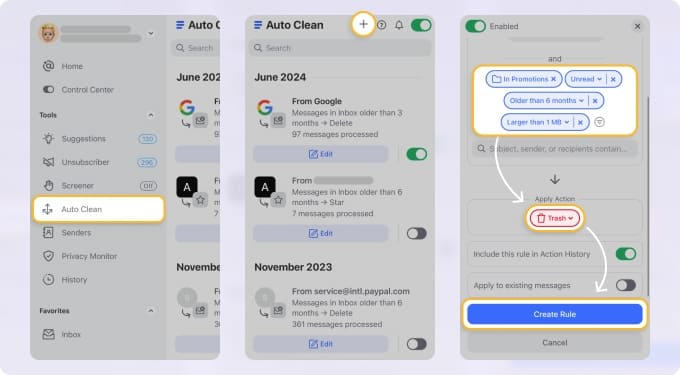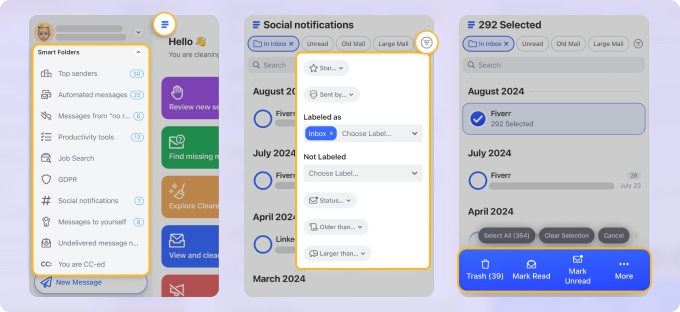Fastmail SMTP Settings
With the right SMTP settings, getting your outgoing mail up and running with Fastmail is a breeze. You can use these SMTP settings whenever you use mailbox:
| Option | Description |
|---|---|
| SMTP Host: | smtp.fastmail.com |
| SMTP Port: | 465 (SSL) or 587 (STARTTLS) |
| SMTP Username: | Your full email address (name@domain.com) |
| SMTP Password: | Your app-specific password. You cannot use your regular Fastmail password. |
Fastmail Server Settings For Receiving Email
Use the following IMAP and SMTP in the configuration of your Fastmail server settings to connect to your mail account using a desktop email client:
Fastmail POP settings
Some people prefer POP over IMAP, even though IMAP has largely replaced it.
| Option | Description |
|---|---|
| POP3 Host: | pop.fastmail.com |
| POP3 Port: | 995 |
| Requires SSL: | Yes |
| POP3 Username: | Your full email address (name@domain.com) |
| POP3 Password: | Your app-specific password. You cannot use your regular Fastmail password. |
Fastmail IMAP settings
IMAP is the best option if you want to read your emails in your mail client from your Fastmail server. IMAP is the most popular choice because it is a more recent standard than POP.
| Option | Description |
|---|---|
| IMAP Host: | imap.fastmail.com |
| IMAP Port: | 993 |
| Requires SSL: | Yes |
| IMAP Username: | Your full email address (name@domain.com) |
| IMAP Password: | Your app-specific password. You cannot use your regular Fastmail password. |
Clean Email Makes Fastmail Even Better
Setting up Fastmail with IMAP or POP is just the beginning. Once your email is up and running, Clean Email helps you keep it neat and stress-free. With Auto Clean, you can set rules to automatically archive or delete emails from specific senders, like old shipping updates or expired promotions. It’s the easiest way to avoid clutter without lifting a finger.


Using Smart Folders, you’ll see your emails grouped into categories like Newsletters, Online Shopping, and Finance, no setup needed. This helps you instantly spot what’s important and clean up everything else in bulk. It’s much quicker than scrolling through emails one by one.


Have a bunch of messages with big attachments eating up space? Use Clean Email’s Filtering to quickly find and delete large emails. Just set your filter for size, and you’ll have a cleaner inbox—and more storage—within minutes.
And the best part? Clean Email syncs directly with Fastmail, so whatever you clean up in Clean Email is instantly reflected in your other devices. You don’t have to change how you check your mail—just enjoy a cleaner inbox wherever you are.
Notes and Additional Information
Your email client and desktop calendar are two examples of services that require an app password to get used with a Fastmail account. Create a password for an app:
- Get to the Passwords section of Password & Security App Passwords.
- Unlocking the app requires entering your password and then selecting New App Password.
- Enter the name of a device. For example, "Outlook on PC" or "Samsung Galaxy calendars" can be entered as descriptive names.
- Decide what information your app can access in the future. Email, contacts, and calendars can all be accessed using the default settings (CalDAV).
- Please select Files (FTP/WebDAV) if you need access to Fastmail's file storage for any app.
- It's time to generate a new password!
💡 Note: Overriding any manual configuration settings that you may have made will be done by Apple Mail. This option is a convenient feature, but it may cause issues with your mailbox. Using Apple's Mail client, you can try disabling the "Automatically detect and preserve server settings" option for your Fastmail account.
Looking for Zoho settings or Yahoo Mail settings? Our Blog's Email Settings category contains specs for all major mail service providers.
POP3 vs. IMAP: What’s The Difference
POP and IMAP can be compared using a simplified version of how they operate.
Email clients connect to email servers first when using POP. All of the mail on the server is retrieved once it's successfully connected to the server. Messages are then stored locally on your device to access them through your mail client. Before disconnecting, it removes the offending messages from the email server and then deletes the entire cache of the server. This function means that the messages will only be accessible on the device that saved them.
Even though most POP setups delete your email from the server by default, you can choose to keep copies of your messages. While this can be useful if you're concerned about losing your mail, it can also quickly cause you to run out of server space.
IMAP is a little different from POP in its operation. Connect to an email server and retrieve your desired content (such as all new emails or a specific message's contents). Because it's locally cached, you can continue working on your device as soon as you change your email. The server processes and saves your changes before disconnecting you.
Although IMAP is a little more complicated than POP, it is the most important thing to keep in mind. You're not downloading all of your emails to your computer. Instead, you're using your email client to access and manage the ones already on the server. Only cached versions of information are retained on your device until you deliberately download something.
Please let us know, and we’ll fix them immediately.